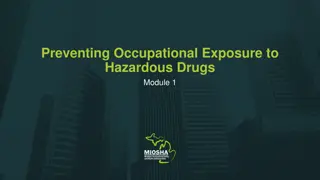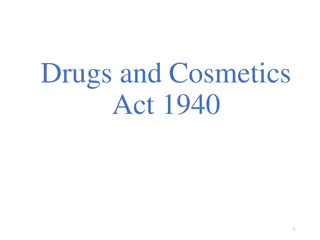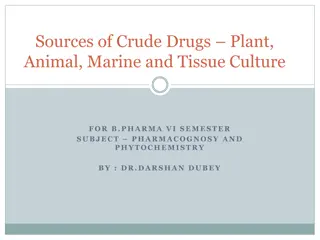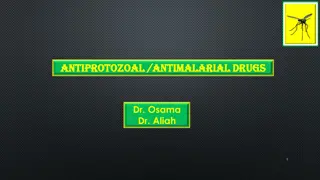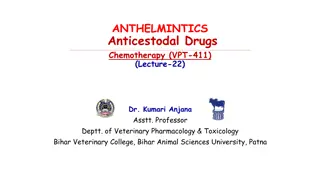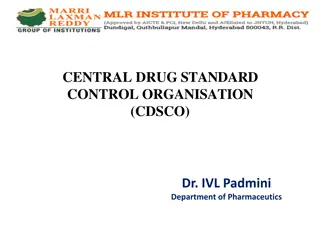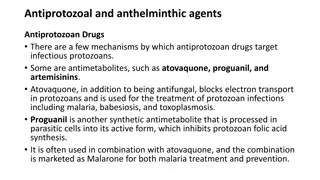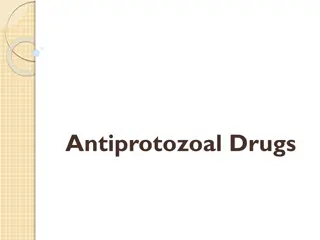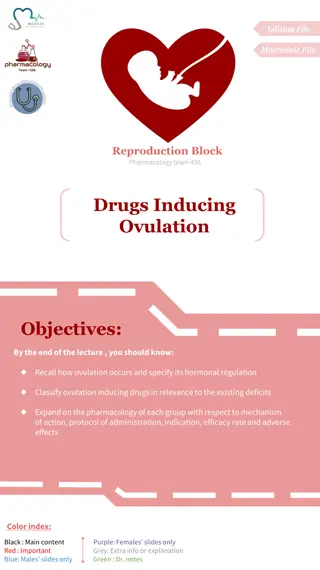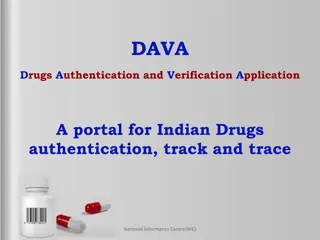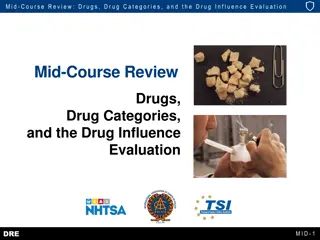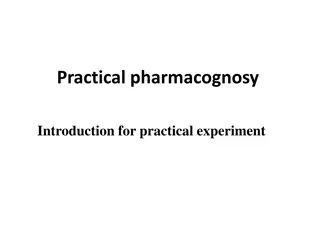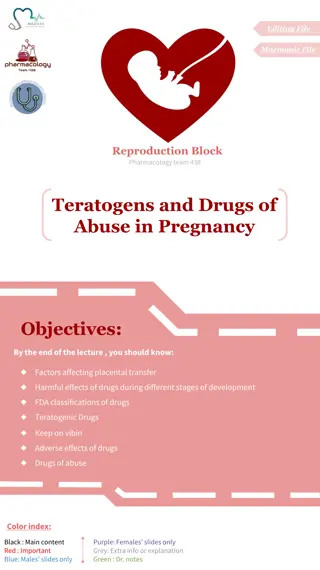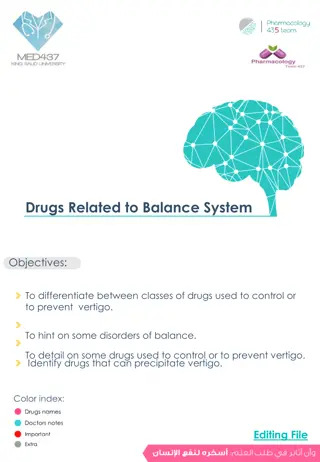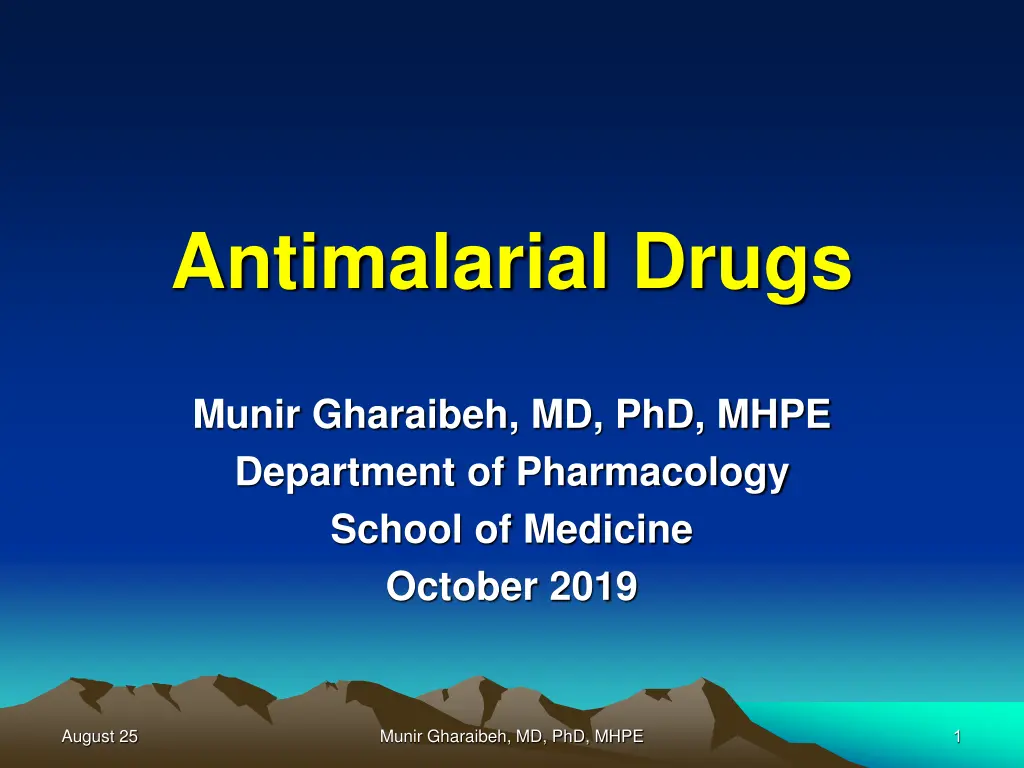
Understanding Antimalarial Drugs - Overview and Treatment
Learn about antimalarial drugs, malaria statistics, types of malarial parasites, and specifics of Chloroquine. Explore different treatment approaches for malaria, including suppressive treatment and prophylaxis, as well as Chloroquine's mechanism of action, resistance issues, and practical usage details.
Download Presentation

Please find below an Image/Link to download the presentation.
The content on the website is provided AS IS for your information and personal use only. It may not be sold, licensed, or shared on other websites without obtaining consent from the author. If you encounter any issues during the download, it is possible that the publisher has removed the file from their server.
You are allowed to download the files provided on this website for personal or commercial use, subject to the condition that they are used lawfully. All files are the property of their respective owners.
The content on the website is provided AS IS for your information and personal use only. It may not be sold, licensed, or shared on other websites without obtaining consent from the author.
E N D
Presentation Transcript
Antimalarial Drugs Munir Gharaibeh, MD, PhD, MHPE Department of Pharmacology School of Medicine October 2019 August 25 Munir Gharaibeh, MD, PhD, MHPE 1
Malaria In 2017, there were an estimated 219 million cases of malaria(296 million in 2015) which resulted in an estimated 453,000 deaths. August 25 Munir Gharaibeh, MD, PhD, MHPE 2
Antimalarial Treatment SuppressiveTreatment ( Clinical Cure: Chloroquin, Quinine, Quinidine, Doxycyline, Clindamycin, Mefloquine, and Halofantrine. = ( Radical Cure followed by Primaquine, required for P vivax and P ovale. : Chloroquin ) ( Prophylaxis: Chloroquin, Mefloquin, Malarone , and Doxycycline. August 25 Munir Gharaibeh, MD, PhD, MHPE 3
Malarial Parasites Plasmodium falciparum (only erythrocytic, serious, resistance). Plasmodium vivax. Plasmodium malariae. Plasmodium ovale. August 25 Munir Gharaibeh, MD, PhD, MHPE 4
August 25 Munir Gharaibeh, MD, PhD, MHPE 5
Chloroquine Synthetic 4-Aminoquinolone Specific uptake mechanism is present in the parasite, the drug accumulates in the parasite to inhibit polymerization of heme into hemozoin and thus parasite is poisoned by heme. Well absorbed, distributed, bound to tissues. August 25 Munir Gharaibeh, MD, PhD, MHPE 6
Chloroquine Schizonticide for all four types of malaria. Drug of choice in the treatment of nonfalciparum and sensitive falciparum malaria. Does not eliminate dormant liver forms of P. vivax and P. ovale, so, Primaquine must be added for their radical cure. August 25 Munir Gharaibeh, MD, PhD, MHPE 7
Chloroquine Resistance: Very common with P. falciparum and increasing with P.vivax. Due to mutation in P170 glycoprotein (PfCRT) works as a drug-transporting pump mechanism . August 25 Munir Gharaibeh, MD, PhD, MHPE 8
Chloroquine Very practical, convenient(oral), rapid action, low cost, and safe. Started immediately after diagnosis. Other doses are given after 6 hours, 24 hours and last dose after 48 hours. However, does not eliminate dormant liver forms of P.vivax and P.ovale. August 25 Munir Gharaibeh, MD, PhD, MHPE 9
Chloroquine Also effective in: Rheumatoid arthritis. LE. Amebic liver abscess. Photoallergic reactions. Clonorchis sinensis. August 25 Munir Gharaibeh, MD, PhD, MHPE 10
August 25 Munir Gharaibeh, MD, PhD, MHPE 11
Chloroquine Side Effects: Headache, dizziness, Itching and rash, Nausea, vomiting, anorexia Unmasking of LE, psoriasis and porphyria. Corneal deposits, blindness, blurring of vision, August 25 Munir Gharaibeh, MD, PhD, MHPE 12
Quinine(1820) and Quinidine Cinchona tree from South America. General protoplasmic poison: will affect the feeding mechanism of the parasite. Resistance is uncommon. Effective rapid schizonticide therapy for severe falciparum, chloroquine-resistant malaria, usually in combination with another drug (e.g. Doxycycline or Clindamycin) to shorten duration of use. August 25 Munir Gharaibeh, MD, PhD, MHPE 13
Quinine and Quinidine Also effective for Babesia microti infection. Also, for nocturnal leg muscle cramps (Arthritis, DM, thrombophlebitis, arteriosclerosis, varicose veins) August 25 Munir Gharaibeh, MD, PhD, MHPE 14
August 25 Munir Gharaibeh, MD, PhD, MHPE 15
Quinine and Quinidine Adverse Effects: Cinchonism: Tinnitus, headache, nausea, dizziness, flushing, visual disturbances. Later, auditory abnormalities, vomiting, diarrhea, and abdominal pain. Blood dyscrasias. Hypersensitivity, hypoglycemia, uterine contractions. Hypotension, QT prolongation. Blackwater fever (hemolysis, hemoglobinemia, hemoglobinurea, and renal failure) August 25 Munir Gharaibeh, MD, PhD, MHPE 16
Mefloquine Blood schizonticide, not for liver forms. Used for resistant P. falciparum (single oral dose ). Also for suppressive and prophylactic treatment (weekly doses). Nausea, vomiting, diarrhea, pain. Vertigo, dizziness, headache, rashes and visual alterations. Psychosis, hallucinations, confusion, anxiety, depression. August 25 Munir Gharaibeh, MD, PhD, MHPE 17
Primaquin 8-aminoquinolone Unknown mechanism. Drug of choice; the only available one, for eradication of exoerythrocytic forms of malaria after treatment with chloroquin. Hemolysis in G6PD deficient patients. Also, nausea, distress, headache, pruritis, leukopenia and agranulocytosis. August 25 Munir Gharaibeh, MD, PhD, MHPE 18
Atovaquone and Proguanil Usually in fixed combination = Malarone . Recommended drug for prophylaxis. Atovaquone also approved for P. jiroveci pneumonia, although has lower efficacy than Trimethoprim-sulfamethaxazole combination. Can cause fever, rash, nausea, vomiting, diarrhea, headache, and insomnia. August 25 Munir Gharaibeh, MD, PhD, MHPE 19
Pyrimethamine Inhibits DHF Reductase Slow and long acting drug. Effective on erythrocytic forms of all species. Not for severe malaria. Preferential binding to parasitic enzyme. Usually combined with Sulfadoxine Fansidar or Sulfones which inhibit Dihydropteroate synthase. No longer recommended for prophylaxis. Also, for Toxoplasmosis( in higher doses ), and P. jeroveci. August 25 Munir Gharaibeh, MD, PhD, MHPE 20
Pyrimethamine Adverse Effects: Anorexia, Vomiting, Leucopenia, Thrombocytopenia, glossitis CNS: Stimulation, Convulsions Allergic reactions including Stevens-Johnson Syndrome August 25 Munir Gharaibeh, MD, PhD, MHPE 21
Antibiotics Tetracycline. Doxycycline. Clindamycin. Azithromycin. Fluoroquinolones. Active against erythrocytic forms of all species. Usually for chloroquine-resistant strains. Also effective against other protozoal diseases. August 25 Munir Gharaibeh, MD, PhD, MHPE 22
Halofantrine and Lumefantrine Rapidly effective against erythrocytic forms of all species. Usually for chloroquine-resistant strains. Well tolerated, except for cardiac toxicity (QT prolongation) August 25 Munir Gharaibeh, MD, PhD, MHPE 23
Artemisnin= Qinghaosu Artesunate. Artemether. Derivatives of Artemisia( ) used by Chinese since 2000 years. Rapidly acting schizonticides against all species. No documented resistance. Work by free radical formation or ATP inhibition. Only drugs reliably effective against quinine- resistant and multi-drug resistant strains. High cost, unavailable. N,V,D, and neurotoxicity in animals. August 25 Munir Gharaibeh, MD, PhD, MHPE 24
Drugs for Leishmania Caused by three Leishmania species: L.tropica causes: Cutaneous leishmaniasis or oriental sore. L. brazeliensis causes: Mucocutaneous leishmaniasis. L. Donovani causes: Visceral leishmaniasis August 25 Munir Gharaibeh, MD, PhD, MHPE 25
Sodium Stibogluconate Pentavalent Antimony ( ) : Binds to SH groups on proteins. Contains 30% to 34% pentavalent antimonyby weight as well as m-chlorocresol added as a preservative. Also, inhibits phosphofructokinase Local, IM or slow IV, irritant. Given for 20-28 days. Drug of choice for all forms of leishmaniasis. Resistance is increasing, especially in India. Cough, V, D, myalgia, arthralgia, ECG changes, Rash, Pruritus. August 25 Munir Gharaibeh, MD, PhD, MHPE 26
AmphotericinB Antifungal agent, difficult to use, and toxic. Alternative therapy for visceral leishmaniasis, especially in areas with high resistance. August 25 Munir Gharaibeh, MD, PhD, MHPE 27
Miltefosine For visceral leishmaniasis. Given orally, for 28 days. Causes V & D, hepatotoxicity, nephrotoxicity, and teratogenicity. August 25 Munir Gharaibeh, MD, PhD, MHPE 28
Pentamidine Inhibits DNA replication. Also, DHF reductase inhibitor Given by IM or IV injection and Inhalation Binds avidly to tissues, but not to the CNS. August 25 Munir Gharaibeh, MD, PhD, MHPE 29
Pentamidine Leishmaniasis: Alternative to Na stibogluconate Pneumocystis jiroveci: Treatment and prophylaxis of patients who cannot tolerate or fail other drugs. Trypanosomiasis: For early hemolymphatic stage. August 25 Munir Gharaibeh, MD, PhD, MHPE 30
Pentamidine Adverse Effects: Rapid Infusion: Hypotension, tachycardia, dizziness. Pain at the injection site. Others: Pancreatic, Renal, and Hepatic toxicity. August 25 Munir Gharaibeh, MD, PhD, MHPE 31
Diethylcarbamazine The drug of choice in the treatment of filariasis, loiasis, and tropical eosinophilia. May also be used for mass treatment and chemoprophylaxis. August 25 Munir Gharaibeh, MD, PhD, MHPE 32
Filariasis August 25 Munir Gharaibeh, MD, PhD, MHPE 33
August 25 Munir Gharaibeh, MD, PhD, MHPE 34
August 25 Munir Gharaibeh, MD, PhD, MHPE 35
Diethylcarbamazine Immobilizes microfilariae and alters their surface structure, displacing them from tissues and making them more susceptible to destruction by host defense mechanisms. The mode of action against adult worms is unknown. Plasma half-life is 2 3 hours in the presence of acidic urine but about 10 hours if the urine is alkaline. August 25 Munir Gharaibeh, MD, PhD, MHPE 36
Diethylcarbamazine Reactions to dying microfilariae are usually mild in W bancrofti , more intense in B malayi , and occasionally severe in L loa infections(fever, malaise, papular rash, headache, gastrointestinal symptoms, cough, chest pain, and muscle or joint pain, leukocytosis, eosinophilia, proteinuria) in patients with heavy loads of microfilariae. Retinal hemorrhages and, rarely, encephalopathy have been described. Antihistamines and corticosteroids might be needed to reduce allergic reactions. August 25 Munir Gharaibeh, MD, PhD, MHPE 37
Ivermectine Ivermectin appears to paralyze nematodes and arthropods by intensifying -aminobutyric acid (GABA) Filariasis Onchocerciasis Strongyloidiasis Also for scabies, lice, and cutaneous larva migrans August 25 Munir Gharaibeh, MD, PhD, MHPE 38
Ivermectin Occasionally induce severe reactions and appears to be more dangerous in this regard than diethylcarbamazine August 25 Munir Gharaibeh, MD, PhD, MHPE 39
Doxycycline Recently shown to have significant macrofilaricidal activity against W bancrofti , suggesting better activity than any other available drug against adult worms. Onchocerciasis. Acts indirectly, by killing Wolbachia. For both treatment of active disease and in mass chemotherapy campaigns. August 25 Munir Gharaibeh, MD, PhD, MHPE 40

